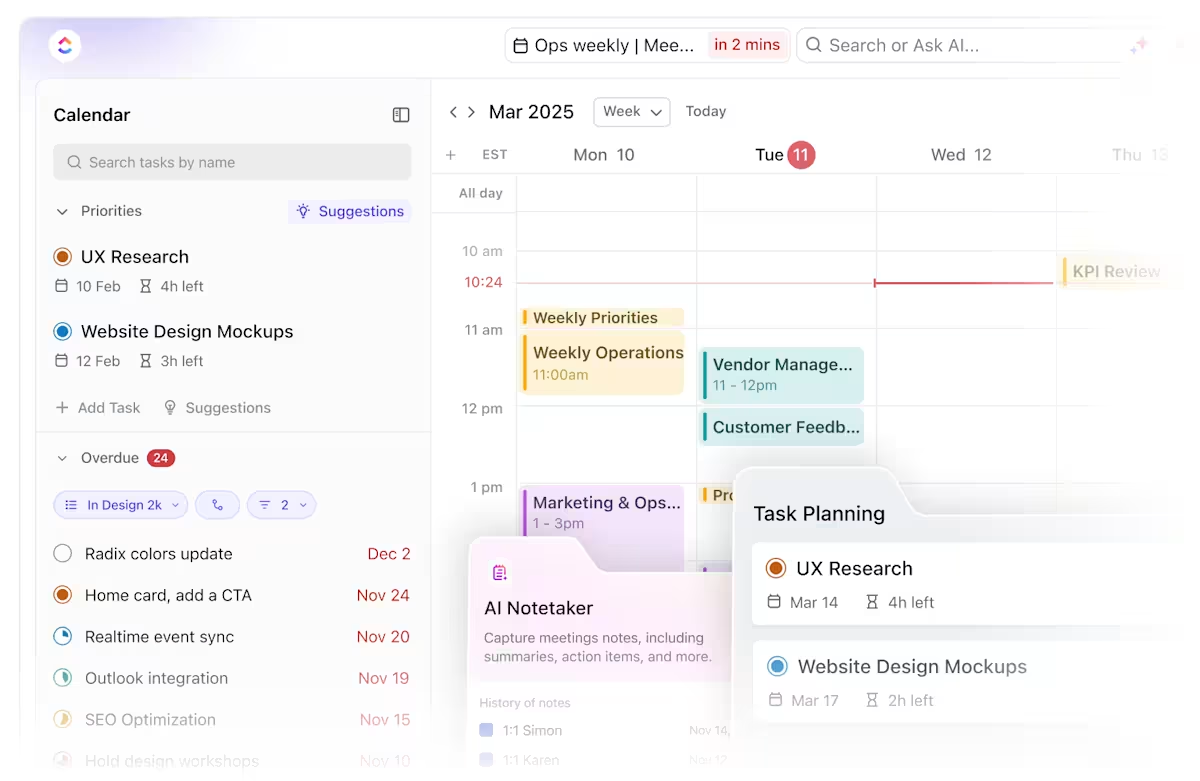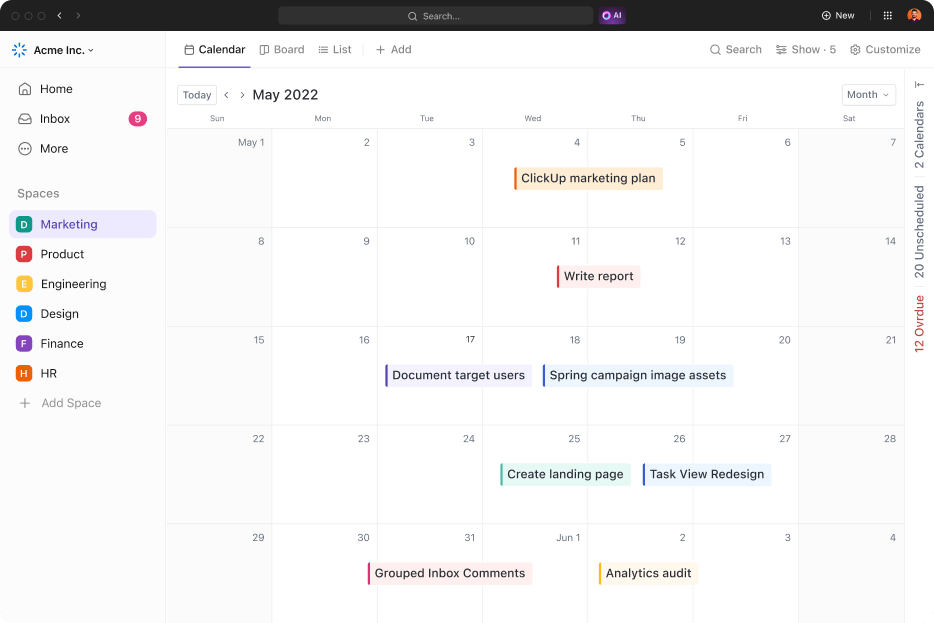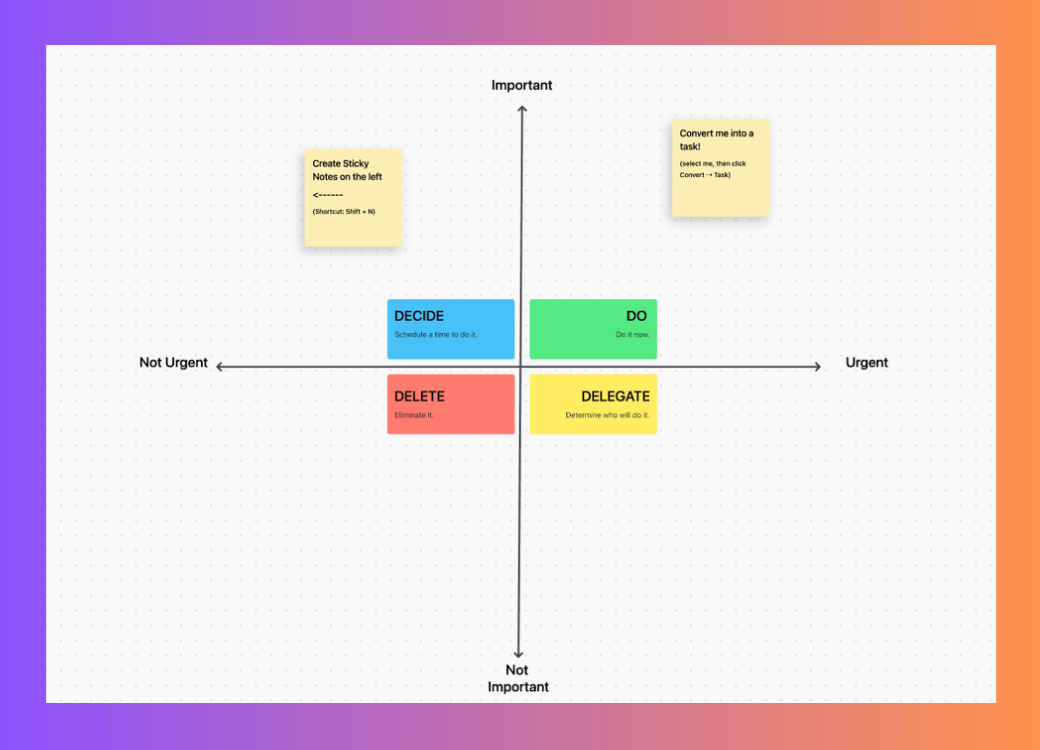Your calendar reflects how you spend your time. If it looks messy, you may not be managing your time right. Think missing important meetings, lapsed deadlines, delayed personal commitments, and more.
Honestly, we’ve all been there: rushing to a meeting we forgot to prepare for, overbooking commitments, forgetting to schedule focus time, and realizing too late that an important task got lost.
The key lies in finding a system that helps you focus on what’s important while keeping the busy work in check. If you need a better scheduling tool, a way to automate repetitive tasks, or just a system that makes sense, we are here to help.
In this blog, we will discuss strategies for optimal calendar management, tips and tricks to stay organized, and how ClickUp can support you with your goals.
What Is Calendar Management?
Calendar management is the process of organizing and optimizing your schedule to stay productive and avoid conflicts.
It focuses on organizing your time so you can work smarter. Techniques like time blocking, task batching, and automation help streamline your schedule, while digital tools take the hassle out of planning.
When done right, your calendar stops being a stress-inducing list of appointments and starts working as a powerful tool for productivity.
🧠 Fun Fact: The Egyptians were the first to create a 365-day calendar, over 5,000 years ago! They based it on the rising of the star Sirius and even had an extra five or six ‘bonus’ days at the end of the year.
📖 Also Read: Productivity Hacks and Tips
Why Is Calendar Management Important?
A disorganized calendar leads to missed deadlines, double-booked meetings, and back-to-back tasks, leading to stress, confusion, and burnout.
Ignoring key planning tools—like reminders and time-blocking—makes staying on top of priorities even harder. Without structure, accountability and efficiency take a hit.
Here’s how effective calendar management can help. 📝
- Boosts productivity: Prioritize tasks, stay focused, and get more done stress-free 👀
- Cuts down stress: No more last-minute scrambles or forgotten deadlines—just a clear plan that keeps you ahead 🙇
- Improves work-life balance: Make time for personal commitments without letting work take over ⚖️
- Enhances teamwork: Avoid scheduling conflicts, keeping team communication and collaboration smooth and efficient 📄
- Saves money: Less overtime, fewer wasted resources, and a more efficient workflow 💰
Common challenges of poor calendar management
Let’s discuss some of the most common challenges people face when calendar management goes off track.
- Double bookings and missed appointments: When your calendar isn’t organized, it’s easy to accidentally schedule two things at once or forget about an important meeting altogether ❌
- Constantly feeling rushed: Without clear time blocks, your day can feel like a never-ending race, leaving you stressed and scrambling to keep up ❌
- Overcommitting: Poor calendar management often leads to saying “yes” to too many things, resulting in burnout and frustration ❌
- Lack of focus: Jumping between tasks without a clear plan can make it hard to concentrate, leading to lower productivity and more mistakes ❌
- Difficulty prioritizing: When everything looks urgent, it’s tough to know what matters so that essential tasks can slip through the cracks ❌
🔍 Did You Know? The names of our weekdays come from gods and celestial bodies. For example, Tuesday comes from Tiw, an Anglo-Saxon god of war, and Thursday is named after Thor, the Norse god of thunder.
Best Calendar Management Strategies
You’re handling back-to-back internal and external meetings and personal commitments while trying to find time for focused work. Without a transparent system, your schedule quickly spirals into overload.
Smart executive calendar management helps here. Take control of your time, reduce stress, and maximize productivity with this guide to building the perfect calendar. 📅
Time blocking
Don’t let meetings and distractions hijack your day. Time blocking helps you proactively assign time for deep work, meetings, and breaks.
Here’s how to block time:
- Define daily tasks: Identify what needs to be done and when you’re most productive. Creating to-do lists definitely helps here
- Block your time: Assign dedicated slots for focused work, admin tasks, and meetings. For instance, 9 to 10 a.m.: Respond to emails. 10 a.m. to 12 p.m.: Project work. 12 to 1 p.m.: Lunch
- Use tools: Try productivity tools to visualize your schedule and send timely reminders
📌 Example: A marketing executive might use time blocking to book mornings for strategic planning, afternoons for team meetings, and evenings for catching up on emails. This way, nothing important is missed.
🔍 Did You Know? The global calendar app market size is projected to reach $16.37 billion by 2030, growing at a CAGR of 10.4%.
Prioritization techniques
Not everything on your list is urgent or even necessary—prioritization frameworks to help you decide what deserves your time.
Here are some you can try.
Eisenhower matrix
The Eisenhower matrix, also known as the Urgent-Important Matrix, is a time management and prioritization tool that helps individuals and teams organize tasks based on their urgency and importance.
It divides tasks into four distinct quadrants, each representing a combination of urgency and importance.
Let’s take a look:
🔴 Quadrant 1: Urgent and Important (do first)
These tasks need your immediate attention and have serious consequences if ignored. They’re the make-or-break moments in your day. Tackle these first thing in the morning when energy is high.
📌 Example: Fixing a company-wide IT outage before it disrupts operations or finalizing a high-stakes presentation due today.
🔵 Quadrant 2: Important but not urgent (schedule it)
These tasks help you grow and succeed, but they won’t scream for attention. If you don’t schedule them, they’ll keep getting pushed aside. Block dedicated time on your calendar to prevent these from getting missed.
📌 Example: Mapping out a long-term business strategy or committing to regular exercise or professional courses.
🟢 Quadrant 3: Urgent but not important (delegate)
These tasks demand attention but don’t necessarily require your expertise. If you can offload them, do it. You can automate or delegate them to free up time for higher-impact work.
📌 Example: Answering routine emails that an assistant can handle or scheduling meetings that interns can handle.
🟡 Quadrant 4: Neither urgent nor important (eliminate)
Let’s be honest—some tasks just waste time. The less of these in your day, the better. Cut down distractions by setting app limits or declining unnecessary meetings.
📌 Example: Mindlessly scrolling social media when it’s not work-related or attending meetings with no clear purpose.
If you’re more of a visual learner, check out the video below: 👇🏼
💡 Pro Tip: Curious about the Eisenhower Matrix and want to see it in action? Check out these Eisenhower Matrix examples.
When you’re ready to start using it, apply any of these Eisenhower Matrix templates to your workspace!
The ABCDE method
The ABCDE method, developed by productivity expert Brian Tracy, is a prioritization technique that helps individuals organize their tasks based on urgency and importance. You categorize tasks into five levels to minimize distractions and inefficiencies.
Here’s how it works:
A: Must do, top priority tasks
These tasks come with serious consequences if ignored. Think deadlines, high-impact work, and non-negotiable commitments. Knock these out first to avoid last-minute panic.
📌 Example: Submitting tax documents before the deadline or preparing for a sales pitch due today.
B: Should do, important but not urgent
These tasks matter, but won’t blow up your day if delayed. They’re essential for long-term success and can wait until A-tasks are done. While these aren’t that important, ensure you schedule these on your calendar.
📌 Example: Mapping out next quarter’s marketing strategy or signing up for an educational course online.
C: Nice to do, but low-priority tasks
These add value but aren’t critical. If time allows, great—but don’t let them take priority over A or B tasks. Use C-tasks as a reward after completing higher-priority work.
📌 Example: Organizing your digital files or attending an optional industry webinar for insights.
D: Delegate tasks that someone else can handle
Not everything needs your attention. If a task can be handed off without affecting results, pass it along. Use automation tools or assign these tasks to free up your time.
📌 Example: Reminders for progress emails or scheduling meetings for the next week.
E: Eliminate these tasks
Some tasks don’t add value at all. Identify these distractions and cut them out. Set boundaries with your managers and teammates and remove unnecessary tasks.
📌 Example: Transcribing an audio file without a clear purpose.
⚙️ Bonus: You can also use the reverse calendar method to simplify calendar management. It’s a planning technique where you start with the deadline and work backward, scheduling key milestones and tasks in reverse order.
Automated reminders and scheduling
Still manually scheduling every meeting or setting reminders? Let automation do the heavy lifting.
You can set up smart reminders with tools like ClickUp, Google Calendar, or Taskade to remind you of meetings, deadlines, or check-ins.
You can also use AI scheduling tools that auto-suggest meeting times to fit everyone’s availability. This helps with remote teams scattered across the world. A great tip is to customize reminders—set multiple for big projects, but limit unnecessary notifications to avoid alert fatigue.
📌 Example: An HR professional automating interview scheduling avoids back-and-forth emails, freeing up time for strategic hiring decisions.
Team calendars
If your team constantly struggles with last-minute schedule changes, a shared calendar ensures transparency and coordination.
Here are some best practices for creating practical team calendars:
- Define roles: Assign team members to manage deadlines, meetings, and project milestones ✅
- Update regularly: Ensure schedules reflect real-time changes to avoid miscommunication ✅
- Create clear agendas: Share clear agendas before meetings with the meeting goal, topic, length, and background information ✅
- Establish collaboration hours: Identify overlapping working hours for distributed teams and rotate meeting times periodically to accommodate different time zones ✅
- Delegate scheduling responsibilities: Appoint a scheduling coordinator to handle shared calendars, send reminders, and resolve conflicts ✅
- Schedule regular check-ins: Keep check-ins short, around 15-30 minutes, to maintain focus and use recurring meetings, weekly or biweekly, to minimize scheduling conflicts ✅
📌 Example: A remote product team uses a shared ClickUp AI calendar, with a PM tracking deadlines and a coordinator managing meetings.
They set core hours (10 AM–1 PM EST), rotate meetings for time zones, and keep check-ins efficient with 15-minute stand-ups and biweekly deep dives.
📖 Also Read: How to Automate Google Calendar Events
Best Calendar Management Tools
The right calendar tool can streamline scheduling, boost productivity, and keep you organized.
Here are some calendar management tools:
- Google Calendar: Syncs with Google Workspace, suggests meeting times, and integrates with Gmail and Drive—ideal for Google users
- Microsoft Outlook Calendar: Works seamlessly with Microsoft Teams and Office 365—great for professionals needing an online meeting tool in the Microsoft ecosystem
- TimeTree: Supports multiple shared calendars with in-app chat—works well for teams and families
- Fantastical: Offers natural language input and Apple device syncing—great for Mac and iOS users
- Wrike: Combines task tracking with a project management calendar—ideal for teams managing workflows
But why settle for basic scheduling or struggle to manage multiple calendars?
ClickUp is the everything app for work that combines project management, knowledge management, and chat—all powered by AI that helps you work faster and smarter.
Unlike standalone calendar apps, this task scheduling software centralizes task management, collaboration, and automation.
ClickUp Calendar

When using separate tools for tasks and calendars, it can get overwhelming to track everything at once.
ClickUp Calendar solves this by providing a fully integrated scheduling solution that syncs tasks, events, and deadlines in one place, eliminating the hassle of switching between platforms.
With two-way sync to external calendars like Google Calendar and Outlook Calendar, every update reflects in real time, ensuring you never miss an important event.

Plus, you can create, edit, and manage meetings directly within the platform.
For example, a marketing team planning a campaign launch can schedule content calendar deadlines, team meetings, and review sessions in a single shared calendar.
ClickUp Brain
ClickUp Brain, your built-in AI assistant, dynamically adjusts schedules in real time, balancing deadlines, priorities, and availability.

Say a product manager is planning a two-hour team workshop, only to have a critical stakeholder meeting pop up. They can use ClickUp AI Calendar to reschedule the workshop without disrupting key priorities, and effortlessly keep the day on track.
ClickUp Calendar View

Want to visualize your work? The ClickUp Calendar View adapts to your workflow with customizable daily, weekly, and monthly layouts, allowing you to plan with clarity. Need to shift priorities? Simply drag and drop ClickUp Tasks to reschedule them instantly.
Color-coded categories help differentiate projects, track deadlines, and gain a quick visual of what needs attention. For enhanced calendar organization, subtasks with specific due dates appear as separate calendar items, clearly showing work progress.
Suppose you’re managing a product launch. The Calendar View lets you color-code critical tasks, track deadlines, and drag and drop tasks instantly. Subtasks like ‘Draft email copy’ or ‘Finalize ad creatives’ appear separately.
ClickUp Calendar Planner Template
Don’t want to start planning an entire calendar from scratch? Turn to ClickUp Templates.
The ClickUp Calendar Planner Template is an excellent tool for planning upcoming events and milestones, organizing projects into manageable chunks, and managing resources effectively.
The schedule template is perfectly customizable, molding into your workflow while offering visibility into overall team progress.
📮 ClickUp Insight: 35% of knowledge workers struggle with productivity on Mondays, overwhelmed by meetings and unfinished tasks.
ClickUp helps you take control of your week with smarter planning, focus time blocks, and real-time updates. With seamless integrations, your workflow stays structured, so you can start strong and productive all week.
Tips for Mastering Calendar Management
Here’s how to take charge of managing your calendar and optimize your time. 📒
- Limit meeting durations: Long meetings can drain productivity. Cap routine meetings at 15-45 minutes and brainstorming sessions for no more than an hour
- Optimize time zones: Careful scheduling ensures inclusivity for distributed teams. Use tools with automatic time zone conversion and record meetings so absent members can catch up
- Perform regular calendar reviews: Analyze how much time is spent on meetings versus focused work based on past calendars, and adjust schedules based on performance analysis
- Combine schedules: Merge work and personal commitments to avoid double-booking
- Stay flexible: Add buffer time between meetings to handle delays and avoid burnout
- Plan weekly: Review and adjust your calendar to stay ahead of deadlines
🔍 Did You Know? The COVID-19 epidemic and shifting work dynamics have led to a trend toward remote work and flexible scheduling. This has increased demand for efficient calendar apps and well-managed calendars, facilitating executive time management and remote collaboration.
Manage Your Calendar and Time with ClickUp
Managing your time and tasks doesn’t have to feel stressful. The right tool can turn scheduling chaos into a seamless workflow, freeing you to focus on what matters.
While tools like Google Calendar and Outlook help with basic scheduling, ClickUp, the everything app for work, is the right option for smart calendar management.
It’s a complete workspace where tasks, projects, and schedules come together effortlessly. With customizable views, real-time updates, and powerful task management, ClickUp keeps you and your team perfectly aligned.
Sign up for ClickUp for free today!





